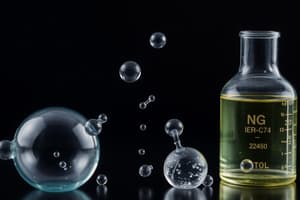Podcast
Questions and Answers
A substance's flammability is considered an intensive physical property because it doesn't depend on the amount of the substance.
A substance's flammability is considered an intensive physical property because it doesn't depend on the amount of the substance.
False (B)
Elements can be broken down into simpler substances by chemical reactions.
Elements can be broken down into simpler substances by chemical reactions.
False (B)
In a heterogeneous mixture, the components are chemically bonded, resulting in a uniform composition throughout.
In a heterogeneous mixture, the components are chemically bonded, resulting in a uniform composition throughout.
False (B)
If a container of gas is heated, and the number of gas particles remains constant, the density of the gas will increase because the particles will move slower.
If a container of gas is heated, and the number of gas particles remains constant, the density of the gas will increase because the particles will move slower.
The volume of a liquid remains constant regardless of the container it occupies due to strong intermolecular forces.
The volume of a liquid remains constant regardless of the container it occupies due to strong intermolecular forces.
Distillation is a method that separates a mixture based on differences in chemical reactivity of the components.
Distillation is a method that separates a mixture based on differences in chemical reactivity of the components.
An increase in temperature always leads to a decrease in the average kinetic energy of the particles within a substance.
An increase in temperature always leads to a decrease in the average kinetic energy of the particles within a substance.
If two different elements have the same number of neutrons, they must be the same element.
If two different elements have the same number of neutrons, they must be the same element.
Heating a metal rod causes it to expand, which is classified as a chemical change because the metal's composition alters.
Heating a metal rod causes it to expand, which is classified as a chemical change because the metal's composition alters.
If 50 grams of substance A react with 20 grams of substance B in a closed container, the total mass of the products will be exactly 70 grams, regardless of any phase changes or energy release.
If 50 grams of substance A react with 20 grams of substance B in a closed container, the total mass of the products will be exactly 70 grams, regardless of any phase changes or energy release.
An object's weight remains constant regardless of its location in the universe, while its mass varies depending on the gravitational pull.
An object's weight remains constant regardless of its location in the universe, while its mass varies depending on the gravitational pull.
A block of aluminum and a block of steel have the same volume. If the density of aluminum is less than that of steel, then the aluminum block has a greater mass.
A block of aluminum and a block of steel have the same volume. If the density of aluminum is less than that of steel, then the aluminum block has a greater mass.
During an exothermic reaction, the temperature of the surroundings decreases as the system absorbs energy.
During an exothermic reaction, the temperature of the surroundings decreases as the system absorbs energy.
Converting kilometers to millimeters involves only one conversion factor because both units are part of same SI system.
Converting kilometers to millimeters involves only one conversion factor because both units are part of same SI system.
A scientist obtains the following weights for a compound: 10.1 g, 10.2 g and 10.3 g. These results can be described as precise, but not necessarily accurate.
A scientist obtains the following weights for a compound: 10.1 g, 10.2 g and 10.3 g. These results can be described as precise, but not necessarily accurate.
Atoms of the same element must have the same number of neutrons, but can have different numbers of protons, leading to isotopes.
Atoms of the same element must have the same number of neutrons, but can have different numbers of protons, leading to isotopes.
When table salt (NaCl) dissolves in water, the oxygen end of water molecules is attracted to the sodium ions because oxygen has a slightly negative charge and sodium ions are positive.
When table salt (NaCl) dissolves in water, the oxygen end of water molecules is attracted to the sodium ions because oxygen has a slightly negative charge and sodium ions are positive.
The chemical formula $C_6H_{12}O_6$ represents an ionic compound because it consists of multiple nonmetal atoms.
The chemical formula $C_6H_{12}O_6$ represents an ionic compound because it consists of multiple nonmetal atoms.
Flashcards
What is matter?
What is matter?
Anything in the Universe that has mass and takes up space.
States of Matter
States of Matter
Solid, liquid, gas and plasma.
What are elements?
What are elements?
A pure substance consisting of only one type of atom.
What are Compounds?
What are Compounds?
Signup and view all the flashcards
What are Mixtures?
What are Mixtures?
Signup and view all the flashcards
Homogeneous Mixture
Homogeneous Mixture
Signup and view all the flashcards
Heterogeneous Mixture
Heterogeneous Mixture
Signup and view all the flashcards
Physical Properties
Physical Properties
Signup and view all the flashcards
Physical Change
Physical Change
Signup and view all the flashcards
Chemical Change
Chemical Change
Signup and view all the flashcards
Law of Conservation of Mass
Law of Conservation of Mass
Signup and view all the flashcards
Mass
Mass
Signup and view all the flashcards
Weight
Weight
Signup and view all the flashcards
Volume
Volume
Signup and view all the flashcards
Density
Density
Signup and view all the flashcards
Energy
Energy
Signup and view all the flashcards
Law of Conservation of Energy
Law of Conservation of Energy
Signup and view all the flashcards
Isotopes
Isotopes
Signup and view all the flashcards
Study Notes
- Matter is anything in the Universe that has mass and takes up space
- Matter exists in different states, most commonly as solids, liquids, gases, and plasma
- Matter is composed of atoms, which are the smallest units of an element that retain its chemical properties
- Atoms are made up of protons, neutrons, and electrons
States of Matter
- Solids have a definite shape and volume because their constituent particles are tightly packed and have strong intermolecular forces
- Liquids have a definite volume but take the shape of their container; their particles are close together but can move past each other
- Gases have no definite shape or volume and expand to fill their container; their particles are widely separated and move randomly
- Plasma is an ionized gas with high energy
Elements and Compounds
- Elements are pure substances consisting of only one type of atom, and cannot be broken down into simpler substances by chemical means
- About 118 elements are known, each identified by its atomic number (number of protons in the nucleus)
- Elements are organized in the periodic table based on their atomic number and chemical properties
- Compounds are substances formed by the chemical combination of two or more elements in a fixed ratio
- The properties of compounds are usually different from those of their constituent elements
- Compounds can be broken down into simpler substances or elements by chemical reactions
Mixtures
- Mixtures are combinations of two or more substances that are physically combined but not chemically bonded
- Mixtures can be homogeneous, with uniform composition throughout (e.g., saltwater), or heterogeneous, with non-uniform composition (e.g., salad)
- The components of a mixture retain their individual properties
- Mixtures can be separated by physical means, such as filtration, evaporation, distillation, or magnetism
Properties of Matter
- Matter can be described by its physical and chemical properties
- Physical properties are those that can be observed or measured without changing the substance's composition (e.g., color, density, melting point, boiling point)
- Chemical properties describe how a substance reacts with other substances or changes its composition (e.g., flammability, acidity, reactivity)
- Intensive properties do not depend on the amount of substance (e.g., temperature, pressure, density)
- Extensive properties depend on the amount of substance (e.g., mass, volume)
Changes in Matter
- Physical changes alter the form or appearance of matter but do not change its chemical composition (e.g., melting, freezing, boiling, tearing)
- Chemical changes involve the rearrangement of atoms and molecules to form new substances with different properties (e.g., burning, rusting, cooking)
- Chemical reactions are processes that involve the breaking and forming of chemical bonds
- Chemical equations represent chemical reactions using chemical formulas and symbols
- The law of conservation of mass states that matter cannot be created or destroyed in a chemical reaction; it is only transformed
Mass and Weight
- Mass is a measure of the amount of matter in an object and is constant, regardless of location
- Weight is the force of gravity acting on an object's mass and can vary depending on the gravitational field
- The SI unit of mass is the kilogram (kg)
Volume
- Volume is the amount of space that matter occupies
- The SI unit of volume is the cubic meter (m³), but liters (L) and milliliters (mL) are commonly used
- Volume can be measured directly with graduated cylinders or calculated from dimensions for regular shapes
Density
- Density is the mass per unit volume of a substance and is an intensive property
- Density is calculated using the formula: density = mass / volume (ρ = m/V)
- Density is typically expressed in units of grams per cubic centimeter (g/cm³) or kilograms per cubic meter (kg/m³)
- Density can be used to identify substances and predict whether an object will float or sink in a fluid
Energy and Matter
- Energy is the ability to do work
- Energy can exist in various forms, including kinetic, potential, thermal, chemical, and electromagnetic
- The law of conservation of energy states that energy cannot be created or destroyed but can be converted from one form to another
- Energy changes often accompany changes in matter (e.g., chemical reactions release or absorb energy)
- Exothermic processes release energy to the surroundings, while endothermic processes absorb energy from the surroundings
Measurement and Units
- Measurements in science involve both a numerical value and a unit
- The International System of Units (SI) is the standard system of measurement used in science, based on seven base units: meter (m) for length, kilogram (kg) for mass, second (s) for time, ampere (A) for electric current, kelvin (K) for temperature, mole (mol) for amount of substance, and candela (cd) for luminous intensity
- SI units can be modified with prefixes to indicate multiples or fractions of the base units (e.g., kilo-, milli-, centi-)
- Accuracy refers to how close a measurement is to the true or accepted value
- Precision refers to how reproducible a measurement is
- Significant figures indicate the number of digits in a measurement that are known with certainty plus one estimated digit
Atoms and Molecules
- Atoms consist of a nucleus containing protons and neutrons, surrounded by electrons in specific energy levels or orbitals
- The number of protons determines the element's identity (atomic number)
- Isotopes are atoms of the same element with different numbers of neutrons, resulting in different mass numbers
- Molecules are formed when two or more atoms are held together by chemical bonds
- Chemical formulas represent the types and numbers of atoms in a molecule (e.g., H₂O for water)
- Molecular compounds are formed from nonmetal atoms sharing electrons through covalent bonds
- Ionic compounds are formed from ions (charged atoms or molecules) held together by electrostatic forces through ionic bonds
Studying That Suits You
Use AI to generate personalized quizzes and flashcards to suit your learning preferences.




